27.2: Exercise
- Page ID
- 105948
\( \newcommand{\vecs}[1]{\overset { \scriptstyle \rightharpoonup} {\mathbf{#1}} } \)
\( \newcommand{\vecd}[1]{\overset{-\!-\!\rightharpoonup}{\vphantom{a}\smash {#1}}} \)
\( \newcommand{\id}{\mathrm{id}}\) \( \newcommand{\Span}{\mathrm{span}}\)
( \newcommand{\kernel}{\mathrm{null}\,}\) \( \newcommand{\range}{\mathrm{range}\,}\)
\( \newcommand{\RealPart}{\mathrm{Re}}\) \( \newcommand{\ImaginaryPart}{\mathrm{Im}}\)
\( \newcommand{\Argument}{\mathrm{Arg}}\) \( \newcommand{\norm}[1]{\| #1 \|}\)
\( \newcommand{\inner}[2]{\langle #1, #2 \rangle}\)
\( \newcommand{\Span}{\mathrm{span}}\)
\( \newcommand{\id}{\mathrm{id}}\)
\( \newcommand{\Span}{\mathrm{span}}\)
\( \newcommand{\kernel}{\mathrm{null}\,}\)
\( \newcommand{\range}{\mathrm{range}\,}\)
\( \newcommand{\RealPart}{\mathrm{Re}}\)
\( \newcommand{\ImaginaryPart}{\mathrm{Im}}\)
\( \newcommand{\Argument}{\mathrm{Arg}}\)
\( \newcommand{\norm}[1]{\| #1 \|}\)
\( \newcommand{\inner}[2]{\langle #1, #2 \rangle}\)
\( \newcommand{\Span}{\mathrm{span}}\) \( \newcommand{\AA}{\unicode[.8,0]{x212B}}\)
\( \newcommand{\vectorA}[1]{\vec{#1}} % arrow\)
\( \newcommand{\vectorAt}[1]{\vec{\text{#1}}} % arrow\)
\( \newcommand{\vectorB}[1]{\overset { \scriptstyle \rightharpoonup} {\mathbf{#1}} } \)
\( \newcommand{\vectorC}[1]{\textbf{#1}} \)
\( \newcommand{\vectorD}[1]{\overrightarrow{#1}} \)
\( \newcommand{\vectorDt}[1]{\overrightarrow{\text{#1}}} \)
\( \newcommand{\vectE}[1]{\overset{-\!-\!\rightharpoonup}{\vphantom{a}\smash{\mathbf {#1}}}} \)
\( \newcommand{\vecs}[1]{\overset { \scriptstyle \rightharpoonup} {\mathbf{#1}} } \)
\( \newcommand{\vecd}[1]{\overset{-\!-\!\rightharpoonup}{\vphantom{a}\smash {#1}}} \)
→ At the beginning of this lab as a class, set up and number 4 potted plants of similar size and type. On each plant, put a bag over one of the branches (or main stem) and tape it closed around the base. Note: the bags should be the same type or the mass of each bag should be recorded beforehand. Water plants 1, 2, and 3 until the soil is saturated. Put plant 1 under a light or next to a sunny window, plant 2 in the dark, and plants 3 and 4 somewhere away from a window but where light is still present. You will check on these later in the lab.
A. Cell Types
Make a thin section of a celery petiole or the main celery stalk. This needs to be very thin to see the features you are looking for, so make a few samples to look at! If you would like to stain your specimen, place the specimen on a slide and add a small drop of Toluidine Blue. Wait a few seconds for the dye to penetrate into the sample, then rinse by adding water to the slide and either soaking up or draining off the excess liquid. When the water is mostly clear, add another drop or two of water and a coverslip.
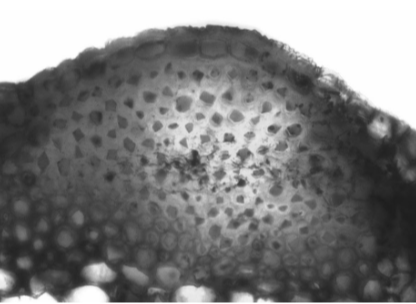
View your specimen under the compound microscope.
You should be able to see several cell types in your specimen. Most of the cells will be parenchyma. A great place to look for textbook parenchyma cells is the outermost layer of the plant, the epidermis.
You will find collenchyma cells in dense clusters near the epidermis in a region called the cortex, forming the strings that you would find in your celery. They appear to have an almost checkerboard-like pattern, due to the unevenly thickened primary walls. In Toluidine Blue, primary walls stain purple.
Some specialized cells can be found in the vascular tissue, organized regions of cells that are transporting water, sugars, and other chemicals throughout the plant body. The xylem is the tissue responsible for conducting water. Specialized cells in the xylem tissue called tracheids and vessel elements have evolved specifically for this ability by forming hollow tubes with lignified secondary walls. Tracheids evolved first and are narrow with tapered ends. Vessel elements evolved in the most recent group of plants, the Angiosperms, and are usually much wider than tracheids. In Toluidine Blue, the lignin in the secondary wall stains bright aqua blue.

The image above shows three different types of cells with secondary walls found in wood pulp. A vessel element is shown in the center with a tracheid running parallel just above it. Note the pits in the walls of both of these cells and the large holes (perforation plates) on the ends of the vessel element only. Criss-crossing the rest of the slide are many thin fibers. All of these cells are dead at maturity and provide structural support due to the lignin in the cell walls.

In the image above, you can see the pits in the walls of a tracheid.
Unlike the xylem, conducting cells in the phloem tissue are alive so they may transport sugars and communication signals in any direction. These cells, sieve tube elements and companion cells, are more similar to parenchyma. The sieve tube elements conduct sugars and have specialized to do this by having reduced cytoplasm contents: sieve tube elements have no nucleus (or vacuole)! These cells are controlled by small, adjacent cells called companion cells. If you look closely, you can also see some sclerenchyma bunched together in the phloem. These are the phloem fibers. Their thick secondary walls should stain the same color as the tracheids and vessel elements.
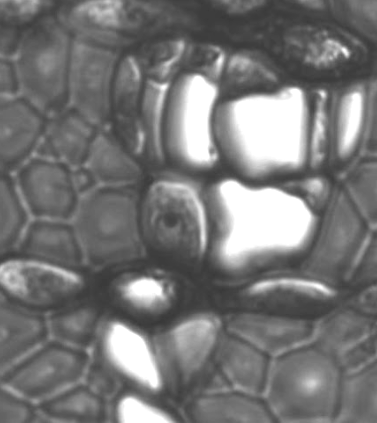
In the image above, you can see clusters of thick walled fibers, large open sieve tube elements, and small companion cells containing nuclei. (A1, A2)
While collenchyma tissue tends to have one job--flexible support--parenchyma and sclerenchyma can fill a diverse set of roles. In a developing pear, there is a high density of a second type of sclerenchyma cells called sclereids (the first type of sclerenchyma cells were fibers). These cells cause young pears to be tough and unpalatable, as the seeds inside are still developing. As the seeds mature, the pear ripens, making more parenchyma cells for storing large amounts of sugar, while the tough sclereids are slowly outnumbered by the larger, juicier cells. The grit that you feel when eating a pear are these remaining sclereids. (A3)
Make a squash mount of the flesh of a pear (not the skin) by scraping off a small amount with a razorblade. Do not take a slice or a chunk, just a tiny bit of pulp (consider chopping it up on the slide). Again, I recommend staining with Toluidine blue, as this should make the thick secondary walls of the sclereids appear a bright aqua blue. Sclereids tend to occur in clusters, surrounded by large parenchyma cells. You may need to gently squish your coverslip down a bit to help disperse these clumps. Coverslips are fragile, so ask your instructor what they recommend before doing anything that might result with glass in your fingers.
When you find a sclereid, you should see lines running through the secondary wall. These are channels where the plasmodesmata extended through to connect to other cells. After the cell dies, only the empty channels (called pits) remain.
Draw a sclereid, located in the ground tissue of a pear. Label the secondary wall, pits, an adjacent parenchyma cell, and the primary wall of that parenchyma cell. (A4, A5)
B. Tissues in the Leaf
When cells of the same type work together to perform a collective function, the collection of cells is called a tissue. For example, the epidermis is a collection of parenchyma-like cells working together to separate the internal environment of the plant from the exterior. The epidermis also contains specialized cells. Trichomes are outgrowths from the epidermis that look like hairs. These can protect the plant from sun damage by being white and reflective, trap evaporating moisture on the plant’s surface, secrete sticky substances, and be unpleasant for herbivores.
A second type of specialized cell in the epidermis is the guard cell. Guard cells are shaped like parentheses and flank small pores in the epidermis called stomata (sing. stoma). When the plant has adequate water, the guard cells inflate and the stoma is open, allowing water vapor to escape through transpiration. When the plant is low on water, the guard cells collapse, closing the stoma and trapping water inside. However, for the plant to perform photosynthesis, it must have access to carbon dioxide and be able to release oxygen. Both of these gases are exchanged through the stomata.
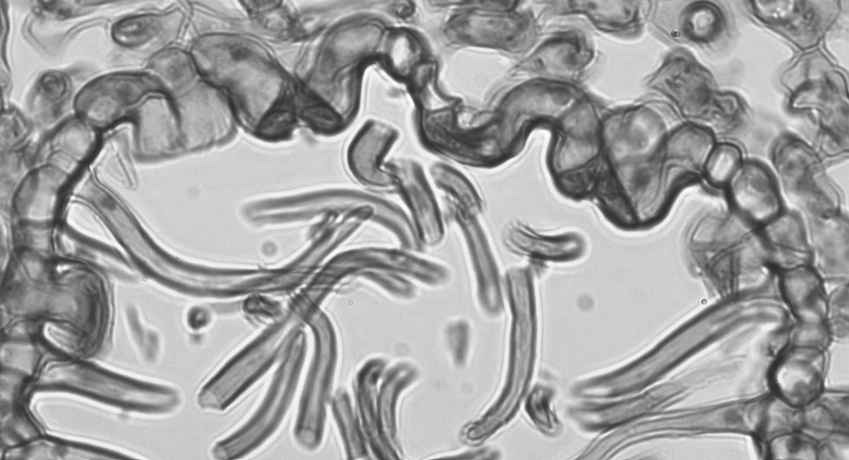
The image above is from the lower epidermis of a Nerium leaf. These plants live in harsh, dry environments and have many adaptations to prevent water loss. This is a pocket on the lower side of the leaf where stomata are located. You can see three different sets of guard cells, currently closed, appearing slightly darker than the other epidermal cells. Surrounding these stomata and filling the pocket are trichomes. (B1, B2)
Peel off the lower epidermis of the leaf, similar to how you removed it from the onion. It may help to break the leaf slowly, hopefully getting a piece of the epidermis that you can peel off. It will look like a transparent layer of skin. Make a wet mount of the epidermis and view it under the compound microscope. Draw what you see below, labeling any specialized epidermal cells. (B3)
When multiple tissues work together to perform a collective function, this collection of tissues is called an organ. While we are familiar with the concept of organs in animals, it can sometimes be surprising to consider this aspect of plants.
An example of an organ in a plant is the leaf. A leaf is surrounded by epidermal tissue, protecting the interior environment, and allowing for the exchange of gases with the environment. The xylem tissue, found in the veins of the leaf, provides the water needed for specialized parenchyma, mesophyll cells, to carry out photosynthesis. Phloem tissue runs alongside the xylem tissue, transporting sugars made during photosynthesis to other areas of the plant for either immediate use or storage. Together, these tissues allow the leaf to function as an organ specialized for photosynthesis. (B4)
C. Plant Organs: Roots
The root system of a plant serves two primary functions: water absorption and anchorage. Roots with a higher surface area will be better adapted to absorbing water because they have more area to interact with the soil environment. Increased interaction with the soil environment can also contribute to increased anchorage, but there are always trade-offs. If roots become too fine, they will be easily broken and lose the anchorage function. Additionally, finer roots can also lose more water if the soil environment becomes dry.
Root Development
In plants, both roots and shoots grow from the tip or apex of the plant. New cells are produced in these growing tips by meristems, groups of undifferentiated cells whose function is to divide by mitosis to produce new cells. Root growth begins at the root apical meristem (RAM). This meristem divides in two directions, producing a root cap to the outside of the root to protect the growing tip and the primary meristems to the inside: the protoderm, ground meristem, and procambium.
Primary meristems produce the primary tissues in the root:
- Protoderm → Epidermis
- Ground meristem → Cortex (and pith in monocots)
- Procambium → Primary xylem and primary phloem
These primary tissues will then either differentiate into specialized cells or, as is the case in many eudicots, become meristematic and produce secondary tissues.
Observe a long section of Zea mays (corn) root tip. This root tip can be divided into three regions based on what is occurring in that stage of development:
Locate the root cap, RAM, protoderm, ground meristem, and procambium. These can be found at the very tip of the root, where the cells are small and densely clustered. If you trace the columns of cells back to their origin, they will coalesce at the RAM. This area of meristematic activity is called the zone of division.

As you move up in the root, the cells begin to get larger, developing into primary tissues. This region is called the zone of elongation.
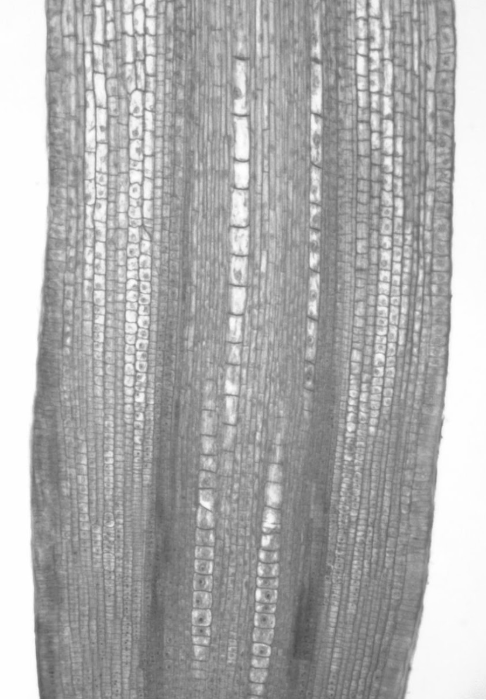
Further up the root, the larger cells begin to differentiate into specialized cells. In the xylem and phloem, you can find sclerenchyma with secondary walls. In the epidermis, you can see elongated cells called root hairs projecting outward. This region is called the zone of maturation.

Locate each of the zones described above and draw a root tip below. In the zone of division, label the root cap and the following meristems: RAM, protoderm, ground meristem, procambium. In the zone of elongation, label the following primary tissues: epidermis, cortex, pith, primary phloem, primary xylem. In the zone of maturation, label the following specialized cells: root hair, sieve tube element, companion cell, vessel element.
Root Development Flowchart
Below is a flowchart of eudicot root development in primary growth. There are two lines that will later lead to the secondary meristems. With this information and the filled in boxes, you should be able to determine which meristems and tissues go in the empty boxes. (C1, C2)
Root Anatomy
Monocots
Observe a cross section of the zone of maturation in a Zea mays root. Locate the primary tissues and specialized cells that you found in the long section and label them in the image below.
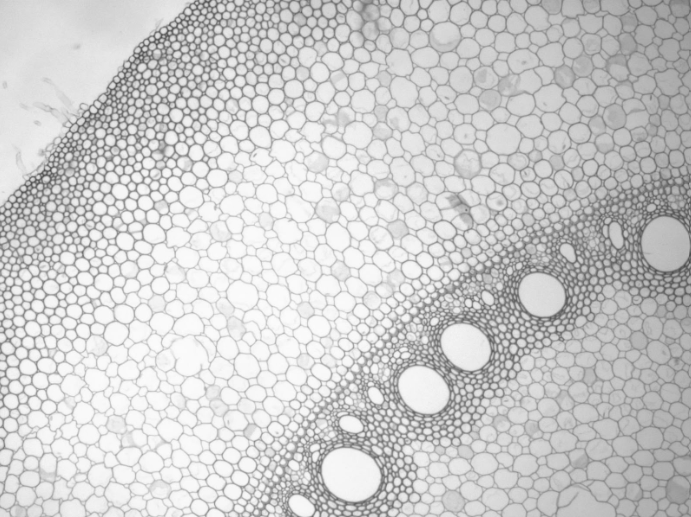
Eudicots
The development of roots in eudicots differs slightly from monocots. Monocots develop a ring of vascular tissue with ground tissue (pith) in the center. In eudicots, the vascular cylinder is closed. The primary xylem develops as an X (or sometimes Y) shape in the center with pockets of primary phloem in the spaces between the arms.
Encircling the conducting tissues is a meristematic layer called the pericycle. This single cell layer is responsible for producing lateral roots. Unlike root hairs which emerge on the outside of the root (exogenous, exo- meaning outside), lateral roots emerge from the internal tissues (endogenous, endo- meaning inside).
Observe a cross section of a Salix (willow) root producing lateral roots. Locate the primary xylem, primary phloem, pericycle, cortex, and epidermis. Label these features in the image below:.

Just outside the pericycle is the innermost layer of the cortex called the endodermis. The endodermis regulates what enters and exits the vascular cylinder. When the root is young, the epidermis contains many root hairs whose function is to absorb water. This water is transported through the cortex and into the xylem. As the root matures, the root hairs are lost from the epidermis. These areas of the root now function for anchorage and transportation of water. Because these areas are no longer taking up water, the vascular cylinder is sealed off by a waxy layer of suberin that covers the endodermis called the casparian strip. The casparian strip forms in stages with the areas closest to the arms of the xylem forming last. These are the last areas to allow for the passage of water, giving them the name passage cells.

Observe a cross section of a Ranunculus (buttercup) root. Locate the pericycle, endodermis, casparian strip, and passage cells. The suberin in the casparian strip often stains similarly to the secondary walls in the xylem. Draw and label the cross section in the space below.
Coleus Shoot Tip
Though it looks a bit alien, this is a section through a growing tip of a plant. In the center, where the alien’s head might be, is a region of small, densely packed cells. This is the SAM of the apical bud. On either side of the SAM, like two upraised arms, are the leaf primordia. These are the early stages of developing leaves. Through the center of these leaf primordia is a darker region of small cells. This is the procambium, which will develop into the vascular tissue. Lining the outer edge of the SAM and the youngest portions of the leaf primordia is the protoderm. As the protoderm matures into the epidermis, it produces hair-like projections called trichomes. Between the protoderm and the procambium is the ground meristem.
On either side of the growing tip are two other darkened lumps of densely packed cells. These bud primordia will develop into axillary buds, producing either branches or flowers. Each bud primordium has its own SAM. (C6)

Monocot Stem
Monocots are a group of flowering plants that produce a single first leaf (cotyledon) as their seeds germinate. Eudicots (frequently referred to simply as dicots) produce two cotyledons. In addition to this feature, monocots and eudicots can be distinguished by several anatomical and morphological features. One of these features is the arrangement of tissues in the stem. In monocots, the vascular tissue is arranged in distinct bundles that are scattered throughout the stem. The xylem is located on the side of the vascular bundles that face the center of the stem and can be identified by the large, hollow vessel elements that stain differently due to their secondary walls. In the half of the bundle that faces the exterior is the phloem, which contains sieve tube elements and their accompanying companion cells. The phloem is capped by a clump of fibers called the phloem fibers. The vascular bundles are arranged throughout the ground tissue in concentric circles with xylem facing inward.
Vascular bundles in monocots are called closed vascular bundles, as they will not go on to form secondary tissues (no residual procambium).


: Zea mays vascular bundle
Observe a cross section of a monocot stem. (C7)
Eudicot Stem
In eudicot stems, the vascular tissue is arranged into a ring (the vascular cylinder) that separates the ground tissue into two distinct regions. The region of ground tissue contained within the vascular cylinder is called the pith. The region of ground tissue that is between the vascular cylinder and the epidermis is called the cortex. Similar to the monocots, the primary xylem is located in the region of the vascular tissue facing the center of the stem, while the primary phloem is produced toward the exterior of the stem.

Observe a cross section of a young Helianthus (or other eudicot) stem. (C8)
Mesophytic Leaf Anatomy
View a prepared slide of a Ranunculus leaf. This small, herbaceous flowering plant is more commonly referred to as a buttercup. It grows in many environments, but tends to prefer shaded, cool spots with plenty of moisture. It is a good example of a "standard" leaf, not specially adapted to either wet or dry environments. This type of plant is called a mesophyte (meso- meaning middle, -phyte meaning plant), preferring moderate climatic conditions.
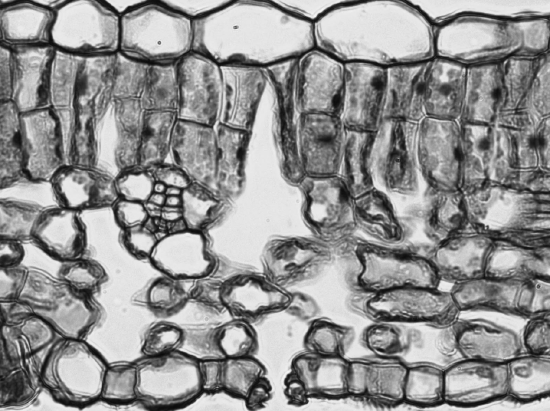
The outer layer of cells on both the upper and lower surface of the leaf is the epidermis. Can you find any pores (gaps) in the epidermis? These pores are called stomata and allow carbon dioxide (
) to enter the leaf for photosynthesis. Oxygen (), which is produced during photosynthesis as a waste product, is released through the stomata. A third gas, water vapor (
), also escapes through the stomata, though this has both beneficial and detrimental effects for the plant.
Look to either side of a stoma (this is the singular version of stomata) to see the flanking guard cells. These cells regulate the opening and closing of the stoma by either inflating and opening when there is high water content in the leaf, or collapsing and closing the stoma when water content in the leaf is low. This prevents water vapor from escaping the plant if it has too little water. However, it also prevents
from entering, stopping the formation of sugars in the plant and cutting of its source of energy. The flow of water vapor out of the leaf helps pull water up from the roots, see lab 5a for a full description of transpiration.
Beneath the upper epidermis is a layer of elongated cells full of chloroplasts. This is the palisade mesophyll, which has specialized for capturing incoming sunlight, rotating chloroplasts to the top of the leaf and then allowing them to regenerate by cycling them toward the leaf's center. Just below the palisade mesophyll is the spongy mesophyll. The spongy mesophyll is full of air pockets (hence the name spongy) that allow
to move into the leaf to the palisade mesophyll, as well as allowing oxygen to diffuse from the palisade mesophyll through the spongy mesophyll and out the stomata.
You may see circles of densely packed cells that both stain a different color than the mesophyll cells, as well as have a different organizational structure. These are veins of vascular tissue running through the leaf. The xylem is on the top, staining differently from the rest of the cells due to its lignified secondary walls. The phloem is on the bottom of the bundle, supported by a cluster of fibers (sclerenchyma) that increase structural support for the veins. The xylem is transporting water and dissolved minerals from the roots up to the leaf, while the phloem is transporting sugars made in the leaf to other regions of the plant. (C9)
Campus Scavenger Hunt
Obtain a list of plant anatomy and organ modifications and use it to explore the plants on campus. How many examples of those listed can you find?

